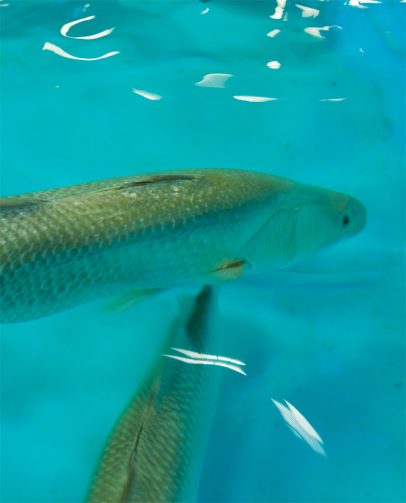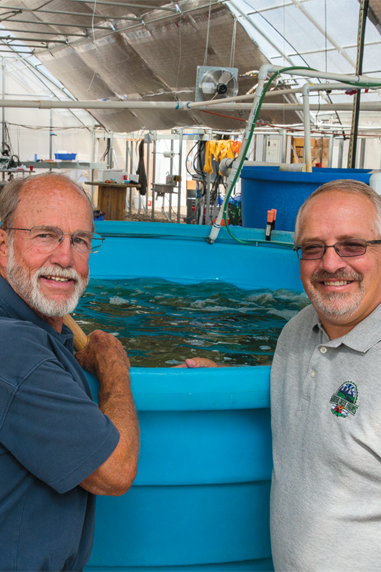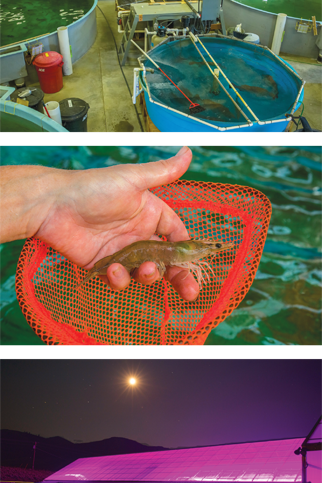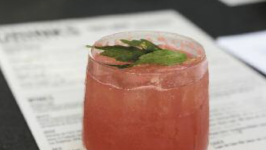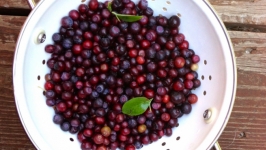Flying Fish
The Magic Valley isn’t the only place where aquaculture has taken hold in Idaho. About 200 miles north of Hagerman and 3,200 feet higher, a power saw whines through a sheet of plywood outside Garden Creek Farms’ greenhouse near Challis. Inside, Sales and Marketing Director John Siggers puts down a hole saw to describe how the farm raises Pacific white shrimp 800 river miles from the ocean.
The facility is a work in progress. “We started with aquaponics,” Siggers begins. Tomatoes, kale and herbs were nourished by waste from outdoor fish ponds. The farm provided vegetables and herbs to local restaurants. Co-owner and Chief Operations Officer Jeri D’Orazio, joins in and explains, “We tried a batch of shrimp in a 200-gallon tank and it worked, so we got more. We were making more [money] from shrimp than the aquaponics, so we started converting to shrimp.”
The 20,000 crustaceans in one of the greenhouse’s raceways creep on the bottom of the structure, which resembles a shallow, black-lined lap pool. Shrimp are harvested every four months, cleaned and frozen in the on-farm processing facility to be sold in local stores, restaurants and farmers markets, including
the Boise Farmers Market.
The hum and splash of the raceway’s saltwater filters and the whir of the greenhouse’s ventilation system mix with the rattle of power tools. Disappointingly, there is no salty odor of the ocean or a sandy beach.
Garden Creek Farms’ indoor recirculating shrimp farm is one of only a few dozen such facilities in the U.S. and the only one in Idaho. The Monterey Bay Aquarium Seafood Watch awards this production method its highest “Best Buy” rating. This is the group’s most environmentally friendly score. These contained farming systems raise shrimp without bycatch deaths from trawling or destruction of mangrove forests for coastal ponds. Knowing the growers who raised the shrimp eliminates concerns about the use of forced labor, as has been reported in Thailand by the AP.
The local and environmentally friendly seafood caught the attention of Chef Bryan Hewett, who enjoys surprising his guests with fresh Idaho shrimp at The Cellar, his Idaho Falls restaurant. Hewett serves Garden Creek Farms shrimp because, “The farm is growing them the right way.”
For the dinner table at home, the farm’s frozen shrimp can be simply boiled. They feel firm to the touch but not rubbery as the skin is peeled. The taste is mildly sweet and buttery, without a trace of brininess.
Garden Creek Farms also strives to feed its community. D’Orazio points out that grocery stores in the U.S. hold only a few day’s supply of food. Natural or human disasters can soon lead to empty shelves. Road closures and other transportation disruptions can be even more common in remote mountain towns like Challis. “As hard as it is to get trucks in here without a disruption,” says Siggers, “if there’s a disruption...?” He shakes his head.
In addition, farm managers buy Idaho materials when they can and look forward to producing more of their own inputs. Their shrimp feed is made in Buhl from animal and plant products and fish oil. In winter, the greenhouse is heated with wood harvested by local cutters and burned in efficient wood boilers.
The farm’s goal of self-sufficiency is paired with a dedication to good stewardship of the land and its resources. Farm owner Christopher James first visited Challis to check on a mine investment. The town captured his heart and drew him and his wife, Debbie, to start new lives. The couple’s Christian faith guides them as they explore ways to achieve this goal in central Idaho.
Besides shrimp, produce and herbs, Garden Creek Farms raises freshwater tilapia and Australian sea bass (also called barramundi) at James’s Shiloh Warm Springs Ranch south of Challis. The operation’s livestock, including Black Angus and Japanese Akaushi cattle, graze the ranch’s irrigated pastures and a geothermal spring provides water for aquaculture.
The tilapia, in their outdoor raceways, ignore visitors and focus on eating. They push wires that drop food into the water; the water churns with flopping and feeding fish. The Australian sea bass live indoors, swimming in large round tanks. These are more refined eaters, which prefer their food sprinkled into the water by human hands.
Twice a week, a truck arrives to haul thousands of live tilapia to Asian communities on the West Coast. Some live sea bass leave on the trucks, too; others are frozen and sold in the same outlets as the shrimp. The taste of Garden Creek’s barramundi fresh off a charcoal grill and spritzed with olive oil and lemon is reminiscent of branzino (another sea bass). Both have delicate white flesh with the mild flavor of butter.
In contrast to salmon, which live in the ocean and spawn in fresh water, sea bass are freshwater fish that spawn in the ocean. Currently, their fry arrives from Australia. Siggers must drive to San Francisco every six weeks to meet the plane and rush the young fish back to Challis. Because of this, Garden Creek is developing a spawning program to produce sea bass fry locally.
A few of the sea bass swim on their sides, looking up to check out visitors. D’Orazio says the fish will come up to be petted by people they know. When the visiting stranger ducks out of sight, the piscine gourmets swim up to push through D’Orazio’s arched hand for a nice rub.
The curious fish are part of Garden Creek Farms’ journey toward food self-sufficiency. The farm plans to consolidate and expand its aquaculture operation at Shiloh Warm Springs Ranch. Shrimp will move to the ranch and their current greenhouse will grow organic produce for Garden Creek Farms’ commercial kitchen.


